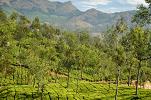|
|
Keralan Cuisine and Kerala Recipes
| Kerala recipes often contain Thenga (Coconut), and this flavour though subtle, permeates Keralan cooking. Other common flavours include cardamom, chillies, coriander, ginger, nutmeg, pepper, fennel, cinnamon and banana - all of which are grown in Kerala. Seafood is naturally popular in Kerala thanks to the state's long coastline and ancient fishing traditions. Fruit and spices grow in abundance here due to the warm, tropical climate and this gives Kerala a rich cuisine filled with freshly harvested, healthy food. Many Kerala recipes, sweet or savoury, contain rice which again grows locally. |
This page includes a guide to the delicious food of Kerala, and other dishes that are popular in south India. It also provides some tips on etiquette, and useful advice for travellers in Kerala regarding food.
Finally some Kerala recipes further down the page, in case you want to try cooking Keralan food for yourself!
Guide to Keralan Cuisine
Breakfast
| A popular and distinctly Keralan breakfast dish is appam. This pancake is usually made from rice flour fermented with toddy or wine. It is thick and spongy in the centre, and thin and lacy on the outsides. Appam is usually served with a mildly spicy vegetable or meat stew. Dosa is a widely served south Indian breakfast - my favourite meal for the morning. It is a large, thin crepe made from rice and black lentils then rolled into a tube. Dosa can be served in numerous ways with any number of fillings, and no two dosas are ever quite the same! A 'masala dosa' is usually a good bet. It has a potato filling and comes with a thin, spicy vegetable broth and wet coconut chutney. Another popular Keralan breakfast dish is idli, a round savoury cake that is wider in the middle than at the edges. It is often made from fermented black lentils and rice, and has a light, fluffy texture. It is usually served with sambar (see below) or fresh banana. Puttu is steamed, moistened rice powder that often comes with grated coconut and is commonly served with curries such as chickpea or chicken. An accompaniment to many meals is sambar (see Kerala recipes below), a broth consisting of dal, tamarind and vegetables. Various Kerala recipes of sambar exist region to region and house to house, depending on local ingredients and preferences. |
Lunch and Dinner
Rice is the staple of most main meals in south India. It can be served with sambar, chicken, fish, vegetable or mutton curries. Parathas - a thick, oily flat-bread sometimes filled with potatoes, meat or vegetable, chapathis - a healthier flat bread made from flour and water and rotis - similar to the chapathi are all commonly served as accompaniments (though they are not traditional Kerala recipes). Sadhya is a traditional Keralan meal served on a banana-leaf plate. It is served at a lot of Kerala festivals, especially Onam. Sadhya is a form of thali, a meal that consists of rice, chapathi, pappadam (a crispy round cracker made with fried rice flour) and several small veg. or non-veg. curry dishes. These vary in flavour, texture and ingredients. Pickle is also included and often a raw onion salad. Saddhya is accompanied by a small payasam - a sweet Keralan desert made from rice and sweetened with sugar, raisins, milk and cardamom.
Snacks and Drinks
| Fruit grows abundantly in Kerala, and snacks of small bananas, coconuts, jackfruits, mangoes etc are eaten at any time of the day. Fried banana chips are a popular snack in Kerala, as are slices of pickled fruit and vegetables. Fresh lime juice with soda is common refresher, and can be served sweet or salted. Tea or chai is often served sweet and milky and flavoured with spices. |
Etiquette and Food Related Tips
Traditional food in Kerala is often eaten from the right hand. Rice is mounded and picked up with the thumb and fore-fingers, then scooped into the mouth using the thumb. Hands should be washed before and after eating, and the left hand should never be used to eat or serve food. Forks, knives and spoons are often set in restaurants and can be provided if requested. Fast food stalls serve delicious and cheap food, and are worth visiting for quick snacks. Avoid tap water, though Keralan water is regarded to be relatively clean, and be wary of items which may have been refrozen. Take a hand sanitiser or your own cutlery for when you get meals on the move, such as on trains or buses.
Some Kerala Recipes
A few Kerala recipes to try for yourself.
Keralan-Style Vegetable Stew
Serves 6.
Ideal served with appam. See below. Procedure
Pour three quarters of a cup of water into the grated coconut and then squeeze the liquid through a tea strainer. Set 'milk' aside.
Pour half a cup of new water into the same gated coconut and squeeze this through tea strainer. Set aside second 'milk'.
Heat the oil and add cloves, cardamom and cinnamon.
Add the onion, curry leaves, chillies and ginger and fry until onion starts to brown.
Add boiled vegetables and stir for a minute, then pour in the second lot of 'milk'.
Boil mix for 6 or so minutes, then season with the salt.
Dissolve the rice four in a little water and add to the broth.
When the broth begins to boil, add first lot of 'milk.'
Upon boiling, remove from heat and season with the mustard seed, pepper and shallot. |
IngredientsHalf a freshly grated coconut.1 and a half cups boiled veg, e.g. potatoes, peas, carrots etc.Oil for frying.1 finely chopped onion.Small piece of ginger, chopped.3 chillies (or 4, depending on taste) chopped roughly.2 small pieces of cinnamon bark.2 green cardamom pods.10 curry leaves.1 tbsp rice flour (or corn starch or flour)
SeasoningA little salt.Ground black pepper.1 tsp mustard seeds.1 shallot, cut into rings.
Appam
Makes 12 pieces.
Requires 2 overnight preparations. Procedure
Soak raw rice in water overnight.
Grind the raw rice (can be done in a blender) until about a quater grain size.
Add grated coconut and a small amount of water, contuinue grinding (or blending).
Add the cooked rice, sugar and yeast and continue to grind (or blend) until the mixture is thin and smooth.
In a large, open container leave to rise overnight. In the morning, add salt and refrigerate until ready to use.
When ready to fry, heat a small bowl shaped pan or tava. Use non-stick pan or a little oil.
Pour a large spoonfull of mix into pan and swirl once so that a little batter sticks to the sides of the pan.
Cover with warmed lid and leave for 2/3 mins.
Remove appam with spatula when it is brown at edges. It will be round with a thick centre and thin lacy edges. |
Ingredients
1 and a half cups fresh grated coconut.1 and a half cups uncooked rice, white.2 or 2 and a half cups of water for grinding / blending.1 tbsp of sugar.2 tbspns cooked white rice.Half tsp yeast (or kefir).Salt to taste.Oil (or ghee) if required.
Kerala recipes courtesy of Wikibooks
If you are travelling to Kerala, check out the guide to the capital of Trivandrum and the historical town of Fort Cochin (and Ernakulam) for information on arrival to the state through these major towns.
More useful advice and guides for travel to Kerala.
^TOP^
Click here to leave Kerala Recipes and return to Travel India Goa Guide Home
Map Of Kerala -
Houseboats Of Kerala -
Kerala Gallery -
History Of Kerala -
Tourist Info Of India

|
|
'Not to be missed' destinations of Kerala
Tea fields at Munnar

Incredible scenery and mountain air in Kerala's tea growing region.
Relaxing on Varkala beach

Varkala attracts worldwide travellers and though laid back, is well established on the backpacker trail.
Historical Fort Cochin

Enjoy the historic buildings, great food and bohemian ambience in Kerala's attractive Fort Cochin.
|
|






